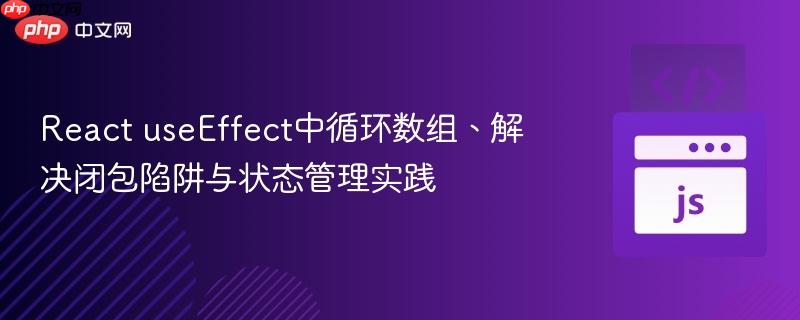
本文深入探讨了在react `useeffect`中使用`setinterval`循环展示数组内容时常见的挑战。我们将解决数组负索引访问错误、`useeffect`闭包导致的陈旧状态问题,并提供两种解决方案:利用`useref`获取最新状态,以及通过优化索引管理逻辑实现无缝循环。旨在帮助开发者理解并避免这些陷阱,编写更健壮的react组件。
在React应用中,我们经常需要实现动态展示内容的功能,例如轮播图或自动更新的列表。useEffect结合setInterval是实现这类功能的常用模式。然而,当涉及到从一个大型数组中按批次(例如每次3项)提取并展示数据,并在到达数组末尾时重新开始循环时,开发者常常会遇到一些棘手的问题,例如数组索引错误、useEffect闭包带来的陈旧状态(Stale State)问题,以及循环逻辑中断等。本文将深入分析这些问题,并提供健壮的解决方案。
在实现数组循环展示时,主要会遇到以下几个核心问题:
在JavaScript中,尝试使用负数索引(例如 array[-1])来访问数组元素是无效的。这不会像Python等语言那样从数组末尾开始计数,而是会返回 undefined。
例如,原始代码中的判断条件:
if (currentTestimonials[-1].localeCompare(currentTestimonials[-1]) == 0)
这里的 currentTestimonials[-1] 会得到 undefined。对 undefined 调用 .localeCompare() 方法会抛出运行时错误,导致逻辑无法正常执行。
解决方案:使用 .at() 方法
ES2022引入的 .at() 方法允许我们使用负数索引来从数组的末尾访问元素。array.at(-1) 可以安全地获取数组的最后一个元素。
// 获取数组的最后一个元素 const lastItem = currentTestimonials.at(-1);
当 useEffect 的依赖数组为空([])时,其内部的副作用函数(包括 setInterval 的回调)只会执行一次,并且会捕获(close over)组件第一次渲染时的状态和 props。这意味着在 setInterval 的回调函数中,你访问到的 currentTestimonials 变量始终是组件初次渲染时的值,即使 currentTestimonials 状态在外部已经被 setCurrentTestimonials 更新了。这就是所谓的“陈旧状态”或“闭包陷阱”。
在原始代码中,useEffect 内部的 setInterval 回调函数捕获了初次渲染时的 currentTestimonials。因此,无论 setCurrentTestimonials 如何更新状态,if 语句中 currentTestimonials 的值始终是最初的 [testimonials[0], testimonials[1], testimonials[2]]。这导致循环重置的逻辑(if (currentTestimonials[-1] ...))永远无法正确判断当前展示的项是否到达了父数组的末尾,从而导致循环在最后几项时中断。
此外,let maxIndex = 2; 变量在组件每次渲染时都会被重新初始化为 2。然而,useEffect 内部的 setInterval 回调函数捕获的是初次渲染时 maxIndex 的引用。在这个闭包内部,maxIndex 会被正确地 maxIndex += 3 和 maxIndex = 2 更新。虽然这在特定场景下(如内部计数器)可以工作,但它不够直观,且如果 maxIndex 需要影响组件的其他部分,则容易造成混淆。
针对上述问题,我们可以采取以下几种解决方案:
useRef 提供了一个在组件生命周期内持久存在的、可变的引用。我们可以利用它来存储 currentTestimonials 的最新值,从而在 setInterval 回调中访问到非陈旧的状态。
实现步骤:
import { useEffect, useRef, useState } from 'react';
export default function SOCarousel({ testimonials }) {
// maxIndex 可以在这里作为局部变量,或者为了更清晰地管理,使用 useState
// 这里我们沿用原答案的 let 方式,但会在注意事项中说明 useState 的优势
let maxIndex = 2;
const [currentTestimonials, setCurrentTestimonials] = useState([
testimonials[maxIndex - 2],
testimonials[maxIndex - 1],
testimonials[maxIndex],
]);
// 使用 useRef 存储 currentTestimonials 的最新值
const currentTestimonialsRef = useRef(currentTestimonials);
useEffect(() => {
// 确保 ref 始终指向最新的 state
currentTestimonialsRef.current = currentTestimonials;
}, [currentTestimonials]); // 当 currentTestimonials 变化时更新 ref
useEffect(() => {
const interval = setInterval(() => {
// 在 interval 回调中,通过 ref 访问最新的状态
if (
currentTestimonialsRef.current
.at(-1) // 使用 .at(-1) 安全访问最后一个元素
.localeCompare(testimonials.at(-1)) === 0 // 比较是否到达父数组的最后一个元素
) {
console.log('HERE: Reached end of testimonials, resetting index.');
maxIndex = 2; // 重置索引
} else {
console.log('ADD THREE: Moving to next set of testimonials.');
maxIndex += 3; // 增加索引
}
// 更新 ref 中的值
currentTestimonialsRef.current = [
testimonials[maxIndex - 2],
testimonials[maxIndex - 1],
testimonials[maxIndex],
];
// 调用 setCurrentTestimonials 触发组件重新渲染
setCurrentTestimonials(currentTestimonialsRef.current);
}, 1000);
// 清理函数,避免内存泄漏
return () => clearInterval(interval);
}, [testimonials]); // 依赖 testimonials,如果 testimonials 变化,重新设置 interval
return (
<div className='carosel-container flex'>
{currentTestimonials.map((testimonial, index) => (
<div className='testimonial' key={index}> {/* 添加 key 属性 */}
<p>{testimonial}</p>
</div>
))}
</div>
);
}注意: 在上述 useRef 方案中,maxIndex 仍然是 useEffect 闭包内部捕获的 let 变量。为了让 currentTestimonialsRef.current 始终保持最新,我们添加了一个额外的 useEffect 依赖于 currentTestimonials 来更新 ref。
更简洁的方法是直接管理一个表示当前起始索引的变量,并基于此变量计算要展示的项。通过检查这个索引是否超出父数组的长度来判断是否需要重置。这种方法通常不需要 useRef 来解决陈旧状态问题,因为我们关注的是索引的逻辑,而不是 currentTestimonials 数组本身的最新值。
实现步骤:
import { useEffect, useState } from 'react';
export default function Carousel({ testimonials }) {
// 使用 useState 管理索引,使其在组件生命周期内保持最新
const [maxIndex, setMaxIndex] = useState(2);
const [currentTestimonials, setCurrentTestimonials] = useState([
testimonials[maxIndex - 2],
testimonials[maxIndex - 1],
testimonials[maxIndex],
]);
useEffect(() => {
const interval = setInterval(() => {
console.log('ADD THREE: Moving to next set of testimonials.');
// 计算下一个 maxIndex
let nextMaxIndex = maxIndex + 3;
// 判断是否超出父数组长度,如果超出则重置
if (nextMaxIndex > testimonials.length) {
console.log('reached end of testimonials! Resetting index.');
nextMaxIndex = 2; // 重置为初始索引
}
// 更新 maxIndex 状态
setMaxIndex(nextMaxIndex);
// 根据新的 nextMaxIndex 更新 currentTestimonials
setCurrentTestimonials([
testimonials[nextMaxIndex - 2],
testimonials[nextMaxIndex - 1],
testimonials[nextMaxIndex],
]);
}, 1000);
// 清理函数
return () => clearInterval(interval);
}, [maxIndex, testimonials]); // 依赖 maxIndex 和 testimonials,确保获取最新值
return (
<div className='carousel-container flex'>
{currentTestimonials.map((testimonial, index) => (
<div className='testimonial' key={index}>
<p>{testimonial}</p>
</div>
))}
</div>
);
}对比与选择:
useEffect 依赖项:
清理函数:
Key 属性:
以上就是React useEffect中循环数组、解决闭包陷阱与状态管理实践的详细内容,更多请关注php中文网其它相关文章!

每个人都需要一台速度更快、更稳定的 PC。随着时间的推移,垃圾文件、旧注册表数据和不必要的后台进程会占用资源并降低性能。幸运的是,许多工具可以让 Windows 保持平稳运行。

Copyright 2014-2025 https://www.php.cn/ All Rights Reserved | php.cn | 湘ICP备2023035733号